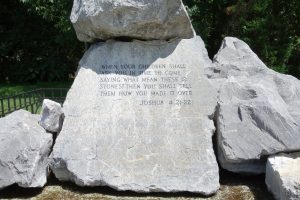Selma Stones – A Weekly Letter From Rabbi Davis – April 25, 2019
Shalom Chaverim,
Visiting Selma on Beth El’s recent civil rights trip, we walked across the Edmond Pettus Bridge. This was the site of the infamous “Bloody Sunday” civil rights march on March 7, 1965.
The bridge is arched so marchers leaving Selma and heading toward Montgomery could not see the other side. It was not until they crested the bridge that they saw police blocking their way. The first time the marchers headed out, they were violently beaten back. A court battle ensued and a few weeks later, marchers were given permission to cross.
 When we crossed the bridge, I was surprised by what we saw on the other side: A memorial of 12 stones inscribed with a verse: “When your children shall ask you in time to come saying “What mean these twelve stones?” Then you shall tell them how you made it over.”
When we crossed the bridge, I was surprised by what we saw on the other side: A memorial of 12 stones inscribed with a verse: “When your children shall ask you in time to come saying “What mean these twelve stones?” Then you shall tell them how you made it over.”
The verse is from the Book of Joshua. There, the passage describes how the Israelites crossed the Jordan river and entered the Promised Land. Like the Sea of Reeds 40 years earlier, the Jordan divided, and the Israelites crossed on dry land. The memorial was established as a reminder for future generations of the possibility of redemption.
The verse is a striking choice for Selma’s civil rights memorial and its message is apt: these marchers were the new Israelites. The descendants of slaves, they helped our nation cross over to the shores of freedom. But notice the subtle shift the memorial makes by comparing the actual verses in the Book of Joshua. The verse says: ‘What is the meaning of those stones?’ tell your children: ‘Here the Israelites crossed the Jordan on dry land.’ For the Lord your God dried up the waters of the Jordan before you until you crossed, just as the Lord your God did to the Sea of Reeds. Thus, all the peoples of the earth shall know how mighty is the hand of the Lord.”
In the Book of Joshua, the stones are a sign of the power of God and the miracles that God performed. In Selma, the twelve stones symbolize the human role in liberation. Indeed, the stones stand adjacent to plaques celebrating a number of heroes of the march including John Lewis, Mary Foster, etc.
At the end of Pesach, we read in the Torah how the Israelites crossed the divided waters of the Sea of Reeds. Even as we acknowledge God’s role in freeing the people, we recognize that it took brave individuals to take the first steps. Then as now.
Chag Sameiach,
Rabbi Alexander Davis
adavis@bethelsynagogue.org
